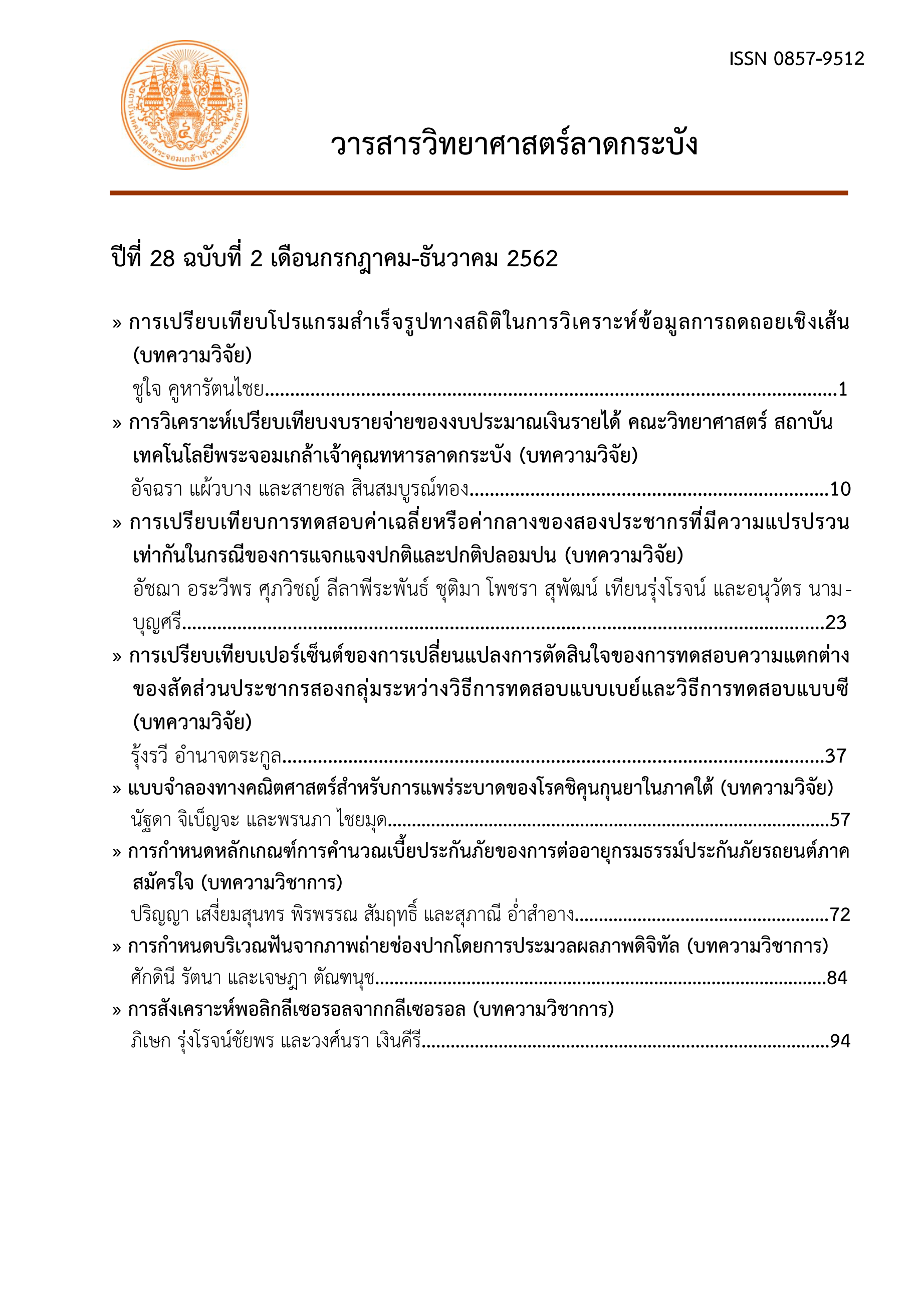A Comparative Study of Reverse Decision Percentage of Inference for two Population Proportions between Bayesian Test and Z Test
Main Article Content
Abstract
บทคัดย่อ
การวิจัยครั้งนี้มีวัตถุประสงค์เพื่อเปรียบเทียบเปอร์เซ็นต์ของการเปลี่ยนแปลงการตัดสินใจระหว่างวิธีการทดสอบแบบเบย์ และวิธีการทดสอบแบบซี เมื่อมีข้อมูลในระยะหลังจากช่วงเวลาที่สนใจทำการศึกษา (Delayed Observations: DO) และพิจารณาผลกระทบของ DO ที่มีต่อวิธีการทดสอบแบบเบย์ และวิธีการทดสอบแบบซี โดยกำหนดค่าสัดส่วนประชากรทั้งสองกลุ่ม 4 ระดับ ได้แก่ (0.5,0.7), (0.4,0.8), (0.2,0.5) และ (0.5,0.5) ศึกษาที่ขนาดตัวอย่าง 60 ขนาดของ DO =10, 20, 30, 40, 50, 60 จำนวน 24 สถานการณ์ ทำการทดสอบที่ระดับนัยสำคัญ 0.05 จำลองสถานการณ์โดยทำซ้ำจำนวน 1,000 ครั้ง สำหรับสมมติฐานที่ใช้ในการทดสอบคือ ต้องการเปรียบเทียบวิธีการรักษาแบบใหม่ให้ผลดีกว่าวิธีการรักษาแบบปกติหรือไม่ และเมื่อมี DO จะทำให้การตัดสินใจเปลี่ยนแปลงไปอย่างไร โดยผลการทดลองเป็นไปได้ 2 แนวทาง คือ ถ้าเป็นกรณีผลจากการรักษาในเพียงระยะแรกของการทดสอบทั้งสองวิธีได้ว่าวิธีการรักษาแบบใหม่ให้ผลดีกว่าแบบปกติ การนำ DO มาร่วมพิจารณาด้วย เปอร์เซ็นต์ของการเปลี่ยนแปลงการตัดสินใจจะมีค่าไม่มากนัก และมีแนวโน้มลดลงตามขนาดของ DO ที่เพิ่มขึ้น แสดงว่าขนาดของ DO มีผลต่อกระบวนการตัดสินใจเมื่อขนาดของ DO มีค่าน้อยๆ แต่ถ้าขนาดของ DO มีค่าเพิ่มขึ้น การนำ DO มาร่วมพิจารณาด้วยนั้น แทบจะไม่มีผลต่อการเปลี่ยนแปลงการตัดสินใจที่ได้จากการใช้ผลจากการรักษาในระยะแรก ส่วนในกรณีถ้าผลการรักษาในเพียงระยะแรกเมื่อการทดสอบทั้งสองวิธีได้ว่าวิธีการรักษาแบบใหม่ไม่ได้ให้ผลดีกว่าแบบปกติ หลังจากมีการนำ DO มาร่วมพิจารณาด้วย เปอร์เซ็นต์ของการเปลี่ยนแปลงการ ตัดสินใจจะมีค่ามาก และเปอร์เซ็นต์ของการเปลี่ยนแปลงการตัดสินใจลดลงจนเข้าใกล้ศูนย์ จนกระทั่งเปอร์เซ็นต์ของการเปลี่ยนแปลงการตัดสินใจของทั้งสองวิธีไม่แตกต่าง
คำสำคัญ : การเปลี่ยนแปลงการตัดสินใจ, วิธีการทดสอบแบบเบย์, วิธีการทดสอบแบบซี สำหรับสัดส่วนประชากร และข้อมูลในระยะหลังจากช่วงเวลาที่สนใจทำการศึกษา
Abstract
The objectives of this research were to compare the percentage of reversing the decision between Bayesian test and Z test when utilizing the delayed observations and to consider the effect of the delay ed observations on the tests. The levels of (p1,p2) were (0.5,0.7) , (0.4,0.8) , (0.2,0.5) and (0.5,0.5) when the sample size was fixed at 60. The delayed observations were 10, 20, 30, 40, 50 and 60. There were 24 situations and each situation 1,000 simulations run were tested at level of significance 0.05. The hypothesis was to test whether or not the new treatment would outperform the normal treatment and how the decision using the delayed observations would differ from the traditional one. The test result of both tests yielded two possibilities. First, if the new treatment was better than the normal one, the percentage of reversing the decision was rather small and was likely to decrease as the delayed observations increased. This showed that the delayed observation was small. In contrast, the large delayed observation had absolutely no effects on the percentage of reversing the decision. The second possibility was that, if the new treatment was not better than the normal one, the percentage of reversing the decision was high and it would gradually decrease and close to 0 until the percentage of reversing the decision of both Bayesian test and Z test did not differ.
Keywords : Reverse decision, Bayesian test, Z test for population proportion, and Delayed observations

